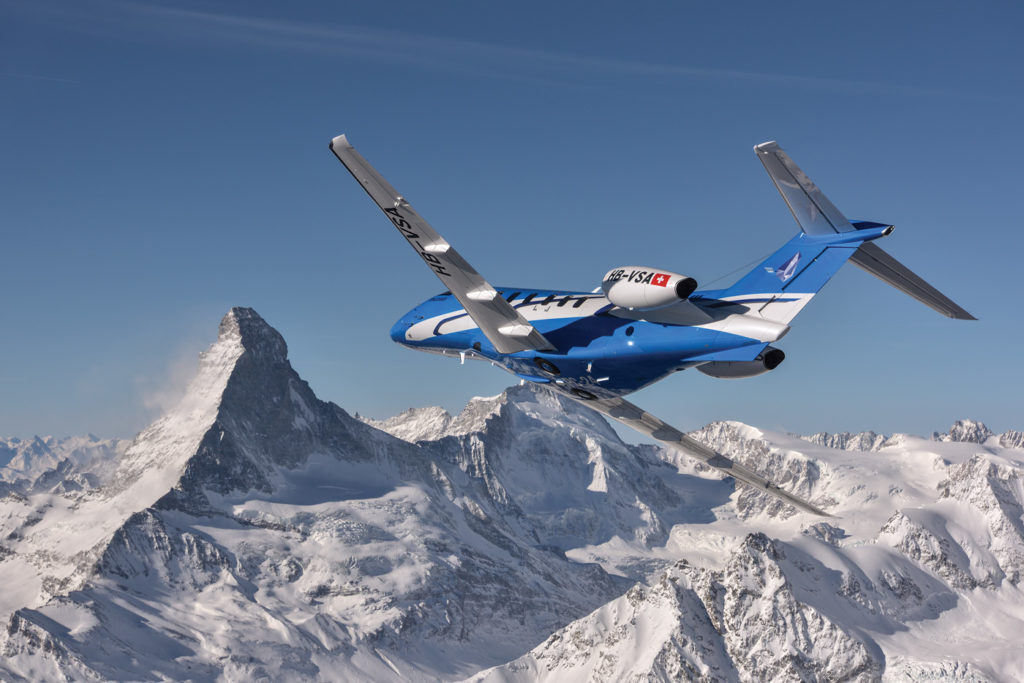PILATUS

New PC-24 surprises with finishing options and performance improvements
At the end of 2023, during NBAA-BACE, Pilatus announced that it had achieved considerable performance gains for the PC-24, with an increase in payload and range, in addition to improvements to the interior.
The increase in numbers occurred after an improvement in wing and fuselage structural elements, allowing the weight of approximately 700 components to be reduced, which were redesigned or had their construction method improved.
Thus, the PC-24, starting with the first deliveries in 2024, had a maximum range with six passengers extended to 2,000 nautical miles (3,704 kilometers), a significant improvement of 200 nautical miles (370 kilometers), which occurred after an increase of 600 pounds (272 kilograms) in the total fuel payload and payload capacity.
Performance...With the improvements, the PC-24 now offers an additional 1,315 pounds (596 kilograms) of total fuel payload in single-pilot operation and has a maximum payload capacity of 3,100 pounds (1,406 kilograms).
The improvements also allow the PC-24 to maintain its operational capabilities on short or unprepared runways, and at maximum takeoff weight at sea level, it can require only 941 meters of runway.

“The increase in payload was achieved through the refinement of the structural elements of the wing and fuselage to reduce the empty weight of the fuselage and, at the same time, increase the maximum gross takeoff weight limit,” highlighted Bruno Cervia, vice president of engineering at Pilatus.
To validate the changes to almost 1,000 items, Pilatus had to conduct an extensive test and flight trials campaign to allow the expansion of the new flight envelope considering higher operating weights and the reduction in the structural weight of the aircraft. Informally, Pilatus executives have come to consider the PC-24 not a light jet, but a very light jet, in a joke about the fact that the weight reduction has made the aircraft more capable.
For Brazil, the expectation is that the new generation will add more capacity, especially for operations in the interior of the country, where most airfields are quite limited in terms of runway length and support infrastructure. It is no coincidence that Synerjet, Pilatus' representative in Brazil, took a PC-24 on a tour of some countries in Latin America, demonstrating the improvements in the design.
Divan...What draws the most attention is the new interior, which has received a series of improvements. Although the changes in weight and performance are important, for many operators, the new interior, which includes the option of a divan, is an additional highlight, if not the main one.
Although the PC-24 already has the largest cabin volume in its category, Pilatus has managed to improve the interior layout with some specific adjustments, in addition to offering new finishes. And here's an addendum: Pilatus, since its robust single-turboprops, such as the PC-6 Porter, which despite having been designed as a robust and simple aircraft, has always stood out for its construction quality and finish, which is essentially a Swiss tradition. The country is famous for its high-precision industry and high-quality products, ranging from watches to roasted coffee to aircraft. The aircraft presented by Synerjet did not have a sofa, but the company itself highlighted its presence and, in a recent interview with the American Aviation Week, Pilatus CEO Markus Bucher said that demand for the accessory has been a great success, and that the company did not expect “people to go so crazy about it”. The justification is plausible: the large side sofa, measuring 1.98 meters long, can be converted into a bed during the flight, in addition to accommodating three people comfortably. The divan is usually a common item in midsize or super-midsize jets, offering a higher level of comfort and a lighter atmosphere on board.
On longer trips, especially at the end of a day of meetings, the divan offers passengers an opportunity to rest during the flight. For families, it is an option to increase the comfort of children, whether in a larger space for distraction or to allow for easier accommodation during sleep. And even in meetings on board, the side sofa invites for a more intimate atmosphere, which can make a difference in certain conversations and agreements.
Configurations... Pilatus also offers a total of six interior configuration options, from the classic layout, through the club seat to the divan. Another important change was the possibility of a rear galley, which, in fact, are two additional cabinets installed in place of the two standard seats, called commuters, at the end of the cabin.
One of the advantages is flexibility, allowing the last two seats to be removed, installing galleys, or even using the free area to transport additional cargo. “Customers usually opt for cabinets or commuter seats, but it is possible to buy both and swap them,” explained Priscila Belo, sales consultant at Synerjet.
In addition, some Brazilian users choose to install executive seats throughout the aircraft, avoiding the two final seats in the standard style. The downside is that it is not possible to remove the executive seats by simply removing a lock, thus requiring work in the workshop and with longer downtime. “Since most of these customers use the aircraft for executive transport, they prefer that everyone has the same seat, avoiding a kind of ‘lesser prestige’ for those traveling in the last [seats],” pointed out Belo.
Low noise...Another highlight of the current project is the declared improvement in environmental noise levels by optimizing the ducts in the passenger service unit, the noise absorption panels and the adjusted engine accessory air intake ducts. Although our team did not travel in the new PC-24, the previous model, which we did an exclusive test on in issue 330, already had a very low internal noise level.
Even so, during our visit, the presentation of the 2024 model, we asked them to simply close the partition between the galley and the passenger cabin, which in itself clearly reduced the external noise.
The aircraft was in the Synerjet hangar and some maintenance operations were taking place next to it, which were not noticeable even during the recording of the video below.
Also noteworthy are the improvements in the cabinet areas and furniture, which have been given a new finish and additional refinement, optimizing the cabin space and also the visual perception.
Pilatus has partnered with Lufthansa Technik to incorporate a new integrated cabin management system (iCMS) with a 10" touchscreen controller with 3D moving map, four high-fidelity cabin speakers with subwoofer option, ambient lighting, USB ports and media storage.
In the cockpit, one of the most visible improvements is the introduction of the touchscreen FMS, making operation simpler and following the trend adopted in larger aircraft, such as the top-of-the-line models from Gulfstream and Dassault.
In fact, this is a feature increasingly present in business jets, the use of avionics with touchscreens that offer the elimination of several buttons, which in practice makes operation simpler and reduces weight. Even though a button weighs less, the entire analog system adds a few extra pounds to the aircraft. In addition, the use of technologies such as smartphones has made it common and simple to absorb the idea of functions on the screen.
Predictive services... Finally, according to Pilatus, all PC-24s from serial number 501 onwards will be equipped with a new feature to enable predictive services. The automated transmission of important aircraft data directly to Pilatus at the time of landing will be analyzed and, if necessary, a predictive recommendation will be made to the operator.
“Increased range, increased payload, increased comfort and improved operability were the main focus of this major PC-24 improvement program. The PC-24 upgrade includes more than 1,000 modifications across the entire aircraft. Once again, we have gone to the limit of what is possible, making maximum use of our engineering capabilities,” Bucher emphasized.
Brazil continues to be one of the markets with the greatest potential for the PC-24, which is already operating under a shared ownership regime and also with private operators, especially on short and medium-haul flights, flying between urban centers and inland cities with short runways.
Vivaero



Comments
Post a Comment